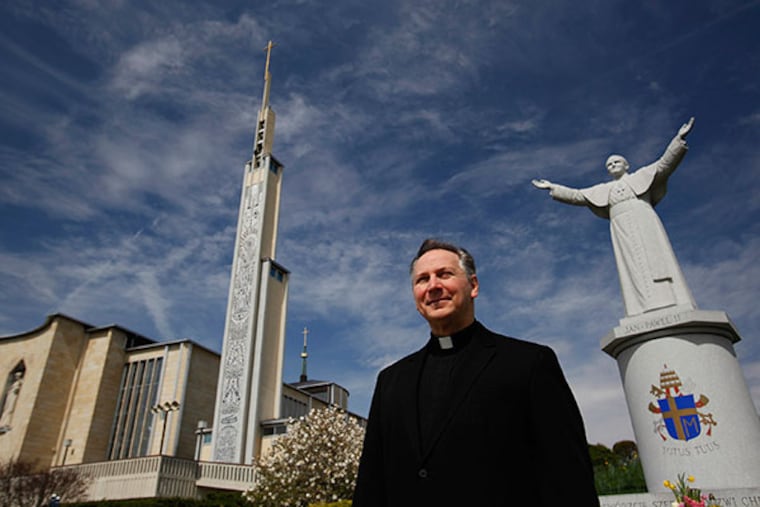Local encounters with a future saint
Like a fan trying to sneak past the velvet rope, 15-year-old George Majoros used his connections. He had washed dishes and bused cafeteria tables at the hilltop complex in Bucks County, so he volunteered for extra duty. Maybe, he thought, he could catch a glimpse.

Like a fan trying to sneak past the velvet rope, 15-year-old George Majoros used his connections.
He had washed dishes and bused cafeteria tables at the hilltop complex in Bucks County, so he volunteered for extra duty. Maybe, he thought, he could catch a glimpse.
Then, the big name Majoros had ditched school to see came into view. The Polish cardinal swept into the National Shrine of Our Lady of Czestochowa in crimson vestments.
Cardinal Karol Wojtyla looked at the teen, shook his finger, and said, "Little boy, you should be in school," Majoros recalled.
That Doylestown meeting 45 years ago was one of several that Majoros, now a Catholic monsignor, would have with the man who became Pope John Paul II.
More than four decades later, Majoros and millions worldwide are preparing to honor John Paul II as he becomes a saint. As the former pontiff is canonized Sunday, Majoros will deliver a homily inside the local shrine, founded to encourage the faith of Polish American Catholics.
"There was something about him," said Majoros, now pastor of St. Jude Church in Chalfont.
Holiness and prayerfulness, the monsignor called it. Their shared background - Majoros is Polish and Slovak - was a bonus.
John Paul II, who served from 1978 to his death in 2005, will be canonized with Pope John XXIII, who was pope from 1958 until he died in 1963.
John Paul II visited the Philadelphia area twice as cardinal and once as pope. In 1979, he celebrated Mass attended by at least one million people on the Benjamin Franklin Parkway.
Schools are named for him: Pope John Paul II High School in Royersford, Pope John Paul II Regional Catholic School in West Brandywine, and Pope John Paul II Regional School in Willingboro, N.J.
Many of the students in the West Brandywine school are "impressed that they remember someone who walked the Earth as a saint," said Sister Anne McGuire, the school's principal. It shows that "the path to sainthood is not something so otherworldly," she said. "It's the way we live our life here."
Students there will participate in a special Mass to commemorate the canonization at 9:30 a.m. Friday at St. Peter Catholic Church near the school.
The canonization of John Paul II is not without critics. Some argue that the process has been rushed.
Others say the late pontiff didn't do enough to fight the clergy sex-abuse scandal and ignored evidence against the Rev. Marcial Maciel, founder of the Legionnaires of Christ, who enjoyed close Vatican ties despite allegations of sexual abuse.
"It remains to be seen how history will judge him," because of the abuse scandal, Majoros said of John Paul II. "I still think he made strides."
During the pope's tenure, the Vatican toughened policies to remove offenders. John Paul II was also on record as saying, "There is no place in the church for this abuse," Majoros noted.
At the shrine in Doylestown, a statue of John Paul II greets pilgrims to the site, founded as a chapel in 1953 and later reorganized as a shrine.
The complex has a room with an archive dedicated to John Paul II that includes relics and vestments worn by the pontiff.
Other relics are housed at locations including the Cathedral Basilica of SS. Peter and Paul in Philadelphia and St. Charles Borromeo Seminary in Wynnewood, where the chair and kneeler the pope used during the 1979 Mass are kept.
John Paul II visited the seminary on that trip. Majoros, then a seminarian, met the pope at the cathedral, where the pontiff greeted those helping with the Mass.
Three years earlier, then-Cardinal Wojtyla came to Philadelphia for the 41st International Eucharistic Congress, a gathering of Catholic clergy, religious, and laity. He visited locations throughout the area, including the Doylestown shrine.
Theresa Romanowski, of Philadelphia, served a meal to the cardinal during that trip.
Romanowski had been friends with a woman who cooked for the religious order that occupies a monastery at the shrine site. She helped with dinner for clergy visiting during the congress.
"Who knew that he would be our future pope and our saint? That's the most amazing thing," said Romanowski, special events coordinator at the Polish American Cultural Center and Museum in Old City.
On Sunday at the shrine, the 2:30 p.m. Mass will be followed by a procession to the statue of John Paul II. Clergy will lay flowers in the pope's memory, said the Rev. Rafal Walczyk, director of the shrine.
Walczyk is scheduled to attend the canonization in Rome with a group of 38 area residents of Polish descent.
Majoros, now 60, will remain at home, preparing his Sunday homily. In 2004, he met John Paul II for the last time, five months before the pontiff's death.
"I was first in line," Majoros said of the meeting in the papal apartments in Rome. By then, the pope had Parkinson's disease and was difficult to understand.
Still, the moment was powerful, Majoros said.
"I didn't want to leave."
610-313-8211